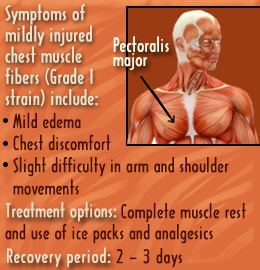A pulled chest muscle is often the result of excessive stretching and tearing of muscle fibers, and leads to chest pain, as well as bruising and inflammation in severe cases. The current article provides signs and symptoms associated with different grades of muscle strains.

Muscles in the chest are involved in various hand and shoulder movements, thus enabling us to perform a wide range of activities. Excess weight or pressure, and sudden jerks, may lead to the stretching of muscles beyond their normal capacity. This results in small tears in the muscle fibers and/or the associated tendons. Such injury may also occur due to physical trauma in the upper torso. This painful condition is called muscle strain or pulled muscle in chest. In most cases, it turns out to be a mild condition, but severe injury has been reported in a few instances.
Pectoralis major and
pectoralis minor are two important muscles present in the pectoral girdle. Pectoralis major is a thick, large muscle that forms a major portion of the chest wall, and is associated with flexion, medial rotation and adduction of the arm. Pectoralis minor is a smaller muscle present beneath pectoralis major, and is mainly involved in shoulder movements. Strain in these muscles, causes chest pain and difficulty while performing regular activities.
Given below is brief account of the people at risk for such a condition, as well as the symptoms associated.
Who is at Risk for Pulled Chest Muscles?Although anyone can experience a muscle strain in the chest, it is more common amongst athletes and those who indulge in weight training. Sportspersons such as tennis players, football and basketball players, boxers, and other professionals who indulge in quick movement of the chest muscles and recurrent usage of the upper body portion, are highly susceptible to a muscle strain in the chest.
Signs and SymptomsNotable symptoms of a pulled muscle in chest are generally experienced within 24 hours after the injury. The most evident sign is pain and tightness in the chest, which worsens as a sharp burning pain during movement and/or rotation of the affected portion. Within a few days, muscle strain may become obvious even while lifting or moving the arms.
Depending on severity of the condition, muscle strains are classified into three grades. The symptoms associated with each grade of muscle strain in chest, have been enlisted below.
Grade IIt involves mild injury to a few of the muscle fibers, and is generally experienced as mild chest pain. Other symptoms may include:
- Mild edema
- Chest discomfort
- Mild loss of strength
- Slight limitation in movements
Grade IIThis grade involves moderate injury that affects a comparatively large number of muscle fibers, and inflicts significant tissue damage or partial muscle tear. Grade II strain in chest muscles may lead to:
- Chest pain
- Mild bruising
- Palpable muscle defect
- Evident loss of strength
- Pain during arm and shoulder movements
- Tenderness and inflammation in the affected area
Grade IIISevere injury that involves a complete muscle tear and loss of muscle function, is considered as a grade III strain. It causes extreme structural damage leading to:
- Severe chest pain
- Loss of strength
- Hematoma
- Inflammation of chest wall
- Limitation of arm and shoulder movements
- Post-treatment persistence of muscle pain
Treatment and RecoveryThe most essential step, in case of a pulled muscle in chest, is to refrain from physical activities which may worsen the condition, namely lifting heavy objects, workouts and heavy exercise. Adequate muscle rest is the main approach for management and treatment of pulled muscles. It may be coupled with the use of analgesics as well as ice-packs and other home remedies. Grade III injuries may require surgical repair and physiotherapy. While a mild muscle pull usually heals within a few days, recovery from grade III injury requires several weeks, or even months.
The symptoms of pulled muscle in chest range from mild discomfort to severe hematoma, depending on the degree of muscle injury. However, any severe muscle pain that affects daily activities, demands a professional consultation in order to understand its etiology, and the severity of damage.
Disclaimer: This Buzzle article is for informative purposes only, and should not be used as a substitute for professional medical advice.


 Muscles in the chest are involved in various hand and shoulder movements, thus enabling us to perform a wide range of activities. Excess weight or pressure, and sudden jerks, may lead to the stretching of muscles beyond their normal capacity. This results in small tears in the muscle fibers and/or the associated tendons. Such injury may also occur due to physical trauma in the upper torso. This painful condition is called muscle strain or pulled muscle in chest. In most cases, it turns out to be a mild condition, but severe injury has been reported in a few instances.
Muscles in the chest are involved in various hand and shoulder movements, thus enabling us to perform a wide range of activities. Excess weight or pressure, and sudden jerks, may lead to the stretching of muscles beyond their normal capacity. This results in small tears in the muscle fibers and/or the associated tendons. Such injury may also occur due to physical trauma in the upper torso. This painful condition is called muscle strain or pulled muscle in chest. In most cases, it turns out to be a mild condition, but severe injury has been reported in a few instances.